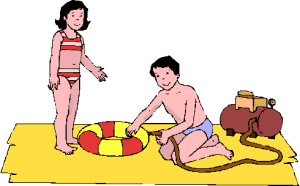|
Development of Sexual Behavior
|
|
Stages of Development: Childhood
|
|
Gender Role Behavior
|
|
The gender role assigned at birth is stabilized and refined in the childhood years. Increasingly different clothing for girls and boys, different hair styles, different toys etc. suggest in subtle, but unmistakable ways that females and males have different social roles to play. This extends even to their anticipated later erotic behavior. For example: Little girls already learn to be modest about their chests – the area where, years later, their breasts will develop. Although the chests of girls and boys look alike before puberty, little girls are usually dressed in full bathing suits or in “bikinis” that cover the upper torso, while boys wear simple trunks, leaving the chest uncovered. Thus, the female chest area is beginning to be “eroticized”, the male one is not. (This observation reminds us once again that it is an error to look for “natural” differences in the erotic behavior of females and males.)
 |
At the same time, adults explain how “a real girl” or a “real boy” is expected to behave. Most children have little trouble accepting and internalizing their gender roles as presented. Indeed, by age 4 at the latest, they have developed a respective unshakeable gender identity: Girls identify themselves as females, boys as males. Gender role and gender identity have then become two sides of the same coin: Femaleness and femininity, maleness and masculinity fit seamlessly together.
However, a few children partially or totally reject their assigned gender roles. Masculine girls (“tomboys”) and feminine boys (“sissies”) may worry their parents, and in exceptional cases the children may even insist on belonging to the other sex: Girls may insist on being boys, and boys on being girls. These problems are discussed in more detail in our course on Gender.
|